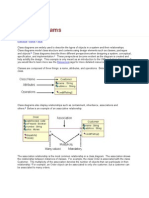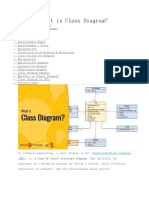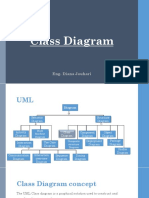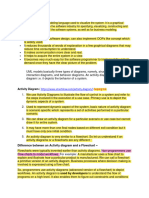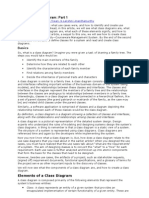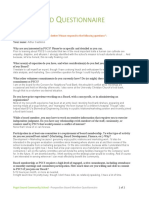0% found this document useful (0 votes)
66 views14 pagesUML Class Diagrams Explained
A class diagram is a static structure diagram used in software engineering to show classes, attributes, operations, and relationships between classes. It helps software engineers develop code by visualizing and documenting an application's design. Class diagrams are key for coding as they form the basis for other diagrams and describe system responsibilities. They are used for analysis, design, and both forward and reverse engineering of applications. A class diagram represents classes as rectangles divided into compartments for the class name, attributes, and operations. It depicts relationships like generalization, association, aggregation, and dependency between classes. Examples of common class diagrams include ones for an ATM, hotel management, library system, online shopping, hospital management, banking, and student registration.
Uploaded by
aayuparulkar0727Copyright
© © All Rights Reserved
We take content rights seriously. If you suspect this is your content, claim it here.
Available Formats
Download as PDF, TXT or read online on Scribd
0% found this document useful (0 votes)
66 views14 pagesUML Class Diagrams Explained
A class diagram is a static structure diagram used in software engineering to show classes, attributes, operations, and relationships between classes. It helps software engineers develop code by visualizing and documenting an application's design. Class diagrams are key for coding as they form the basis for other diagrams and describe system responsibilities. They are used for analysis, design, and both forward and reverse engineering of applications. A class diagram represents classes as rectangles divided into compartments for the class name, attributes, and operations. It depicts relationships like generalization, association, aggregation, and dependency between classes. Examples of common class diagrams include ones for an ATM, hotel management, library system, online shopping, hospital management, banking, and student registration.
Uploaded by
aayuparulkar0727Copyright
© © All Rights Reserved
We take content rights seriously. If you suspect this is your content, claim it here.
Available Formats
Download as PDF, TXT or read online on Scribd
/ 14














